
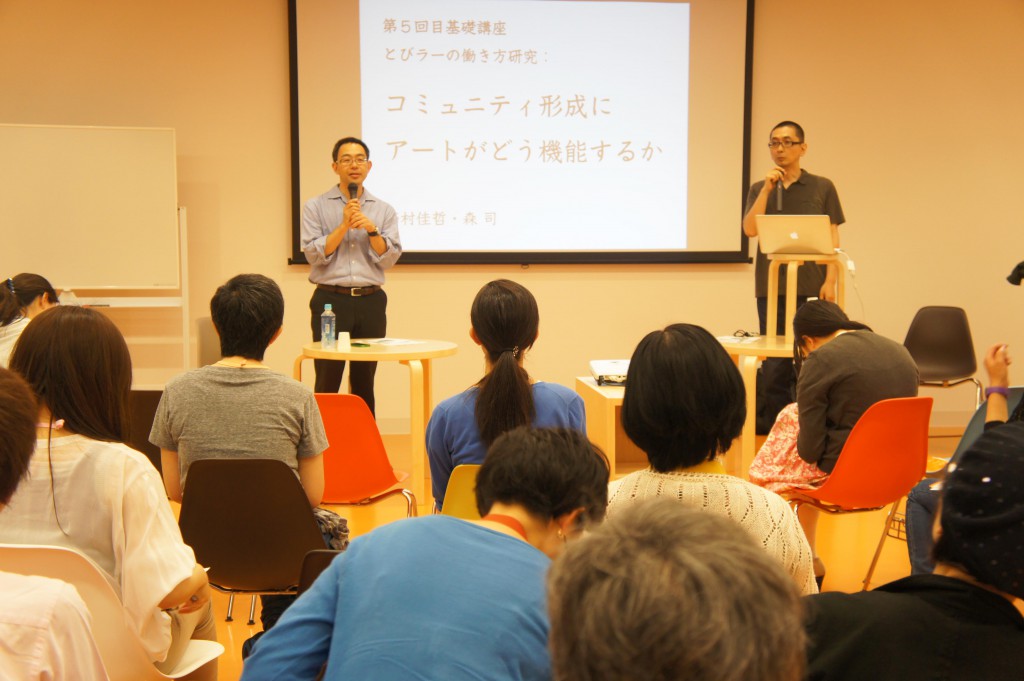
The theme of the 5th Foundation Course is “Research on How TOBIRAs Work.” The lecturers are Mr. Yoshiaki Nishimura (working methods researcher / Living World representative) and Mr. Tsukasa Mori (Section Chief, Tokyo Culture Creation Project, Regional Cultural Exchange Section, Tokyo Metropolitan Foundation for History and Culture). With the Foundation Courses coming to a close, from here on the TOBIRA candidates (hereinafter called “TOBIKO”) will see how they can actually work in the setting of the Tokyo Metropolitan Art Museum (hereinafter called “TOBI”). This course was held for that possibility and preparation.
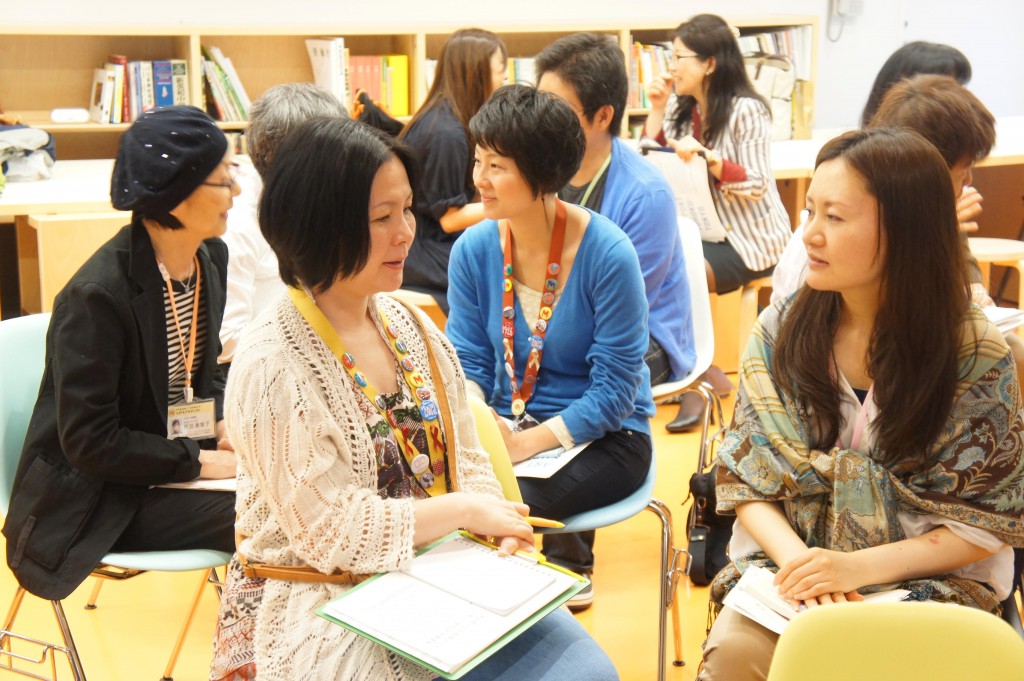
At first, Mr. Nishimura put forward the theme of “The TOBI Gateway Project and Who I Am Now.” When the Course participants became TOBIKOs, they became quite familiar with TOBI and developed bonds with other TOBIKOs. Different plans began to sprout, and he has begun to realize the great expectations and challenges of conduct for TOBIKOs. To look back a little on the present, the TOBIKOs paired up and discussed their recent circumstances. Of course, the most important issue was “listening ability.” Mr. Nishimura once again advised that “listening ability” means “truly having an interest and concern in that person.”
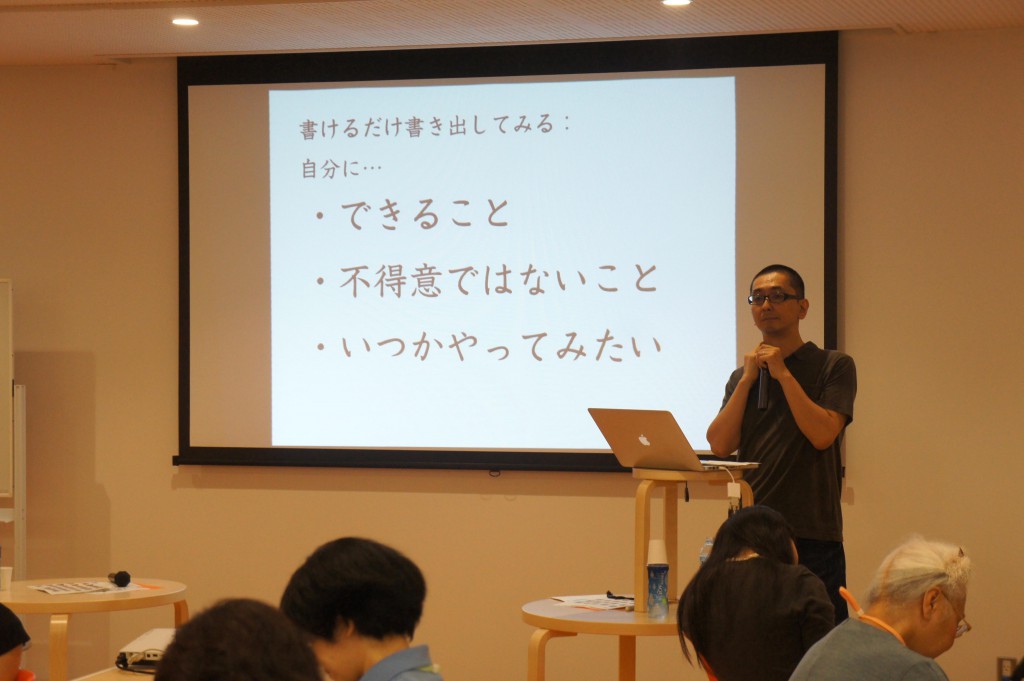
After that, Mr. Nishimura spoke about “the style of not prioritizing the mission, but whoever happens to be there is everything” with the example of a talk by Mr. Hideki Toshima (originally at Graph) who he met at a lecture titled “3 Days to Think about one’s Work” (2009). He worked on such projects as the installation design of Mr. Yoshitomo Nara’s works, and he said that the design company Graph, performing on a global stage, was started by 6 friends who gathered together with their canned coffee drinks on the stone steps of the Nakanoshima Public Hall in Osaka. At that time, people such as half craftsmen or cooks gathered after work to talk about the current circumstances of such things as each other’s dreams and work. In that situation, one of the members made a chair, and at that point Graph’s activities started to move. Graph grew rapidly with the chain of ideas “If you can make a chair, I’ll go sell it. If we can sell it, we’ll need mass production and that will require a studio, right? If so, then let’s rent a building, then we can make a showroom, then I will have a café there.” They didn’t decide on their mission and goals and then recruit the people with the necessary abilities, but potential sprouted from the people who happened to be there. This vague method of sharing things like each other’s dreams and potential to find the shape of the future by thinking “it’s something like this” is “the style of not prioritizing the mission, but whoever happens to be there is everything.”
This “the style of not prioritizing the mission, but whoever happens to be there is everything” is the actual common point with the “day after tomorrow potential” that the TOBI Gateway Project envisions. (For more about “day after tomorrow potential,” please refer to “Educe cafe: Bringing out the Community through Art” that took place on June 6th at The University of Tokyo.) I want the TOBI Gateway Project to take great care of the various faces that gather at TOBI and the vague image of the future arising from accumulating achievements which are only possible at TOBI.
To tell the truth, the image of the activities for the TOBIRA Gateway Project wasn’t firmed up when planning began. Not even the curator, Ms. Inaniwa, myself (I really hadn’t even dreamed that I would be the Project Manager) or any of the instructors had even imagined anything at this time last year. However, we met, spoke with and shared feelings with people, we thought and became impassioned, and bit by bit, we built the principles and direction of the TOBI Gateway Project. It can really be said that the form of this TOBI Gateway Project came about exactly because of the staff that we have. So I want to have the same stance in connecting with the objective of TOBIRA activities.
Whether these thoughts were certainly included or not (I’m not sure), Mr. Nishimura next instructed us to make groups of three people from the members gathered here and for those people to think of unique ideas. He said that the image of the smallest social unit is three people in a group. They soon made groups of three people and began with each person writing in a notebook “what I can do,” “what I’m not bad at” and “what I’d like to try sometime.” After writing in the notebooks, they chose just one of those words and wrote it on post-it notes that were distributed.
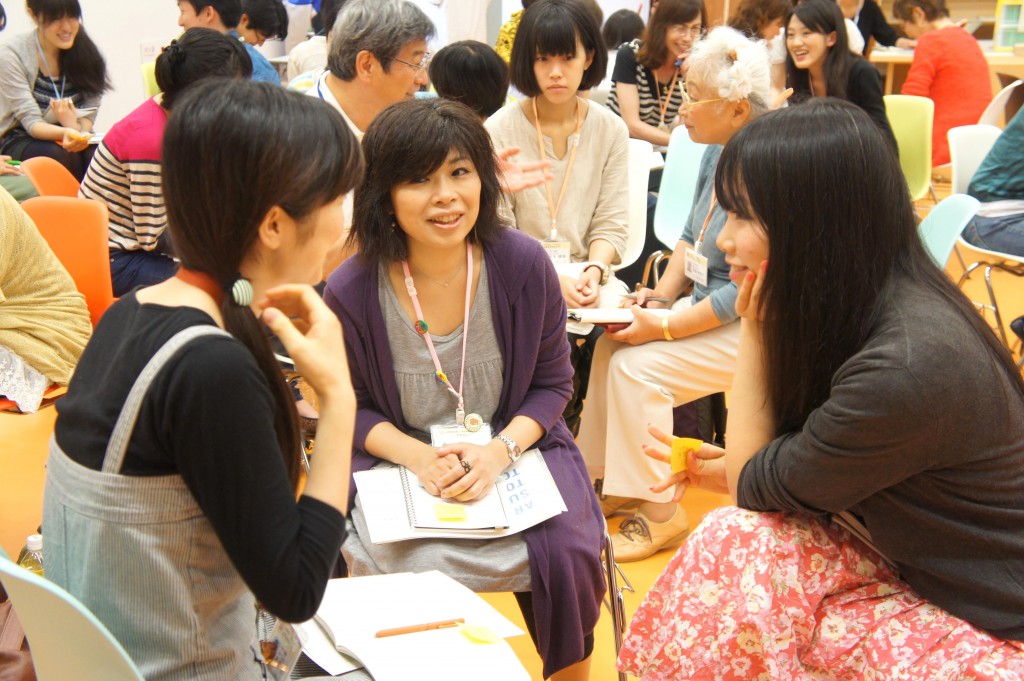
They showed each other the post-it notes with the words they chose, and the three members thought of an idea from those three words. At first, they came up with ideas unrestrained by the place called “TOBI.” Since they came here, this was the first time they realized that the other TOBIRA candidates had unexpected special skills that were many hidden hints which may be useful in future activities.
After the three members tried once to form a simple planning idea, they then continued deepening the image. Next time, these three will think about what they can do at TOBI. While discussing what they themselves can do in the setting of TOBI bringing their three words, the morning ended. Each group was then assigned homework to submit their plans on one A4 sheet of paper by the afternoon, and an active meeting continued even into the lunch break.
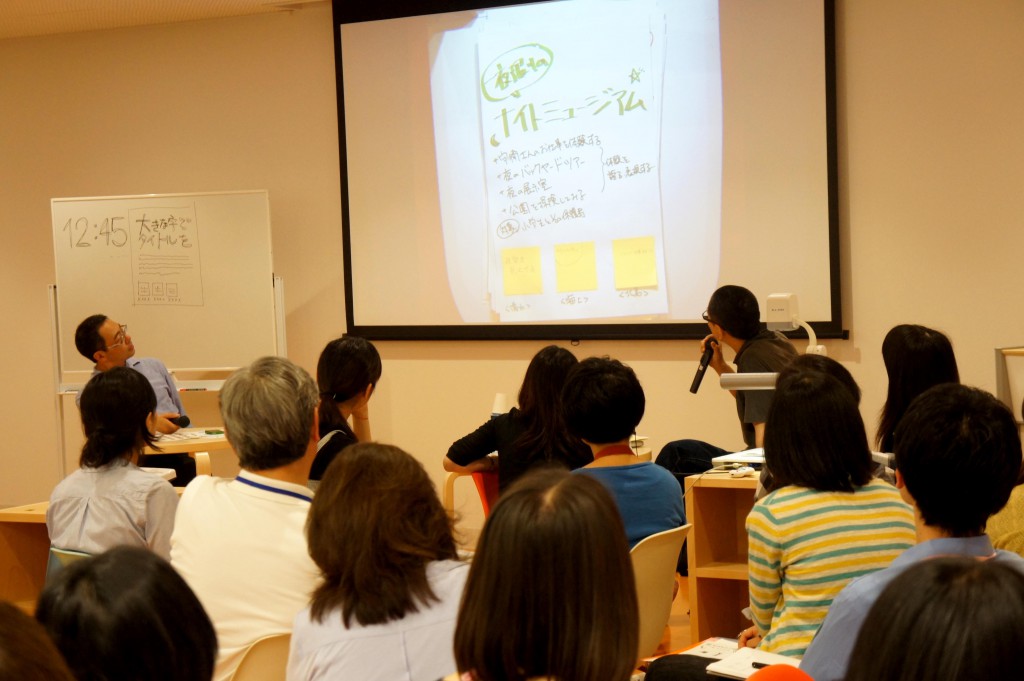
Lunch break ended and the afternoon session started. Mr. Mori joined and checked each of the plans. With Ms. Shiomi, (“I want to go skydiving”), Ms. Komatsu (“I want to travel all over Japan”) and Ms. Hirano (“I want to be in the newspaper for something other than a bad thing”), it was like “TOBIRAs jumping out of the sky.” (Laughs) “TOBIRAs will skydive into all parts of Japan. We will have the letters ‘TOBI’ written on the parachutes. We will take pictures where we land and display them at TOBI.” There’s no way that will work. Other than that, a lot of unique ideas like a “night museum” and “Roaming around and cleaning TOBI” came about.
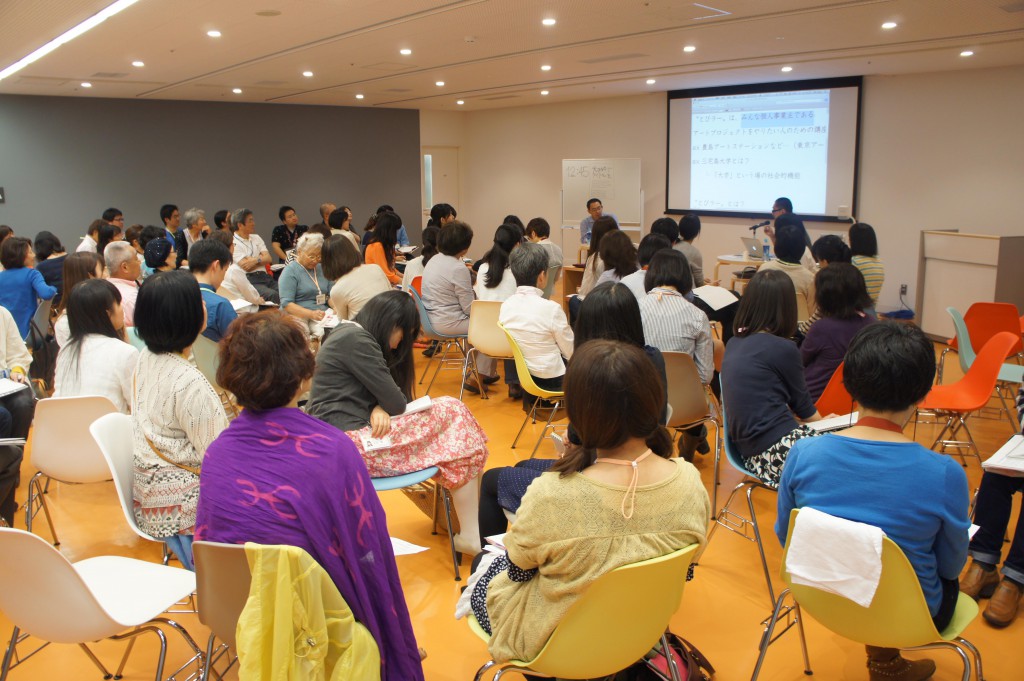
Mr. Mori provided severe and pertinent advice combining both realistic and not realistic ideas such as “Planning means that, even while you are expanding an image based upon many ideas, you should be taking it down into a simpler action plan” and “an itemized plan just consisting of a list of everyone’s ideas isn’t called planning.”
After comments on the planning reports had once finished, Mr. Mori said the sharp comment: “A lot of ideas emerged, but from here the problem is who exactly is going to carry them out?” Then, the expectations of TOBIRAs were expressed with the term of a “new public commons1.”
As my own little addition to “new public commons,” in the 1980s based on the thought that the town would become cultural if you made a cultural facility, there was a period called “box (building) administration (public policy focusing on the construction of public buildings)” that built the many community centers and halls. There were certain expectations such as: if you build the box, people will come and cultural activities will develop; if cultural activities occur, the effects will spread to the facility’s surrounding areas and there will be flowers and sculptures. But this didn’t happen at all. How do you use a multipurpose facility that anyone can use? They became places with no clear purpose and were even derided as “places with luxurious chandeliers completely lacking in exuberance.” The root cause of this failure lies in the idea that, “if you have the “hard,” the “soft” will naturally occur. Then, when it became clear that the energy of activities lies not in the buildings but in people, the Japanese economy fell into a decline with the collapse of the economic bubble. Ultimately, even if you make the “box,” there is no meaning if you don’t think about the contents. Rather, if you have the contents, there were claims that the “box” could depend on ingenuity. As a result, the era has been shifting “from “boxes” to people” and from “hard to soft” (because this is the time of art projects being developed in the middle of communities). The thought until now that the role of profit return to communities with boxes should now be entrusted to people and not a box is included in the term “new public commons.”
However, there is the question of “What will TOBIRAs do as the bearer of this “new public commons?” I am forced to think deeply about this as the Project Manager. When I looked from the perspective of a place to actually carry out a project, the extremely difficult point was that an actionable “plan” and an “idea” are clearly different. This is just my interpretation, but I think that “plan” can mean “strategy.” I mean, this is finding a path while making an overview of the expected future. If you have this image (even if its vague), even if things happen like you fail along the way or your actions don’t go well, you will accumulate these as results. But the failures and actions of your ad-hoc “thoughts” can easily produce discouragement and despair. You can’t waste the energy that you’ve worked so hard to store up. This is because “ideas” will go no farther than the “strategy” of doing something to the scene right in front of you. It’s difficult to have a bird’s eye view. Therefore, repeating “strategies” (ideas) without grand “strategies” (plans) will lead to extremely dangerous acts in running a project.
I think probably a general way to avoid this is to gather at the progress stage of the project and present the common “strategies” (plans) of all members each time and then proceed with an appropriate division of roles. However, I dare to say that in the TOBI Gateway Project I’m thinking of not doing that. This is also one of the challenges of the TOBI Gateway Project. Even regarding the “strategy” (plan), for example, if it were me, I would think at what step we could continue growing the TOBI Gateway Project. About all of the TOBIKO, I don’t necessarily think they all have to share one common thought about what kind of self-realization is possible and what they should do now toward that end. It’s important for each of them to find their own “path” (strategy) in their own motivation. Without deciding a permanent division of roles to build an organization, I want an organic team assembly progressively structured by the TOBIRAs, each with their own “strategy” (plan), to be able to continue painting an overview of the TOBI Gateway Project. I know that the obstacles are quite high, but Mr. Mori and Mr. Nishimura have said in their talks that “TOBIRAs are each a ‘one-man business.’” That’s exactly what I think, too. TOBIRAs aren’t volunteers in given roles.
A “new public commons” does not simply mean volunteers working. It calls into question each individual’s maturity and experience, and a very high level of performance is expected. Those that can become the “new public commons” will be the centrifugal force of activity woven into the TOBI Gateway Project. That is the great expectation of the project which I would like the TOBIKO to really feel.
Also, with these great expectations, the question of “What do you do next?” has been posed to the TOBIKO.
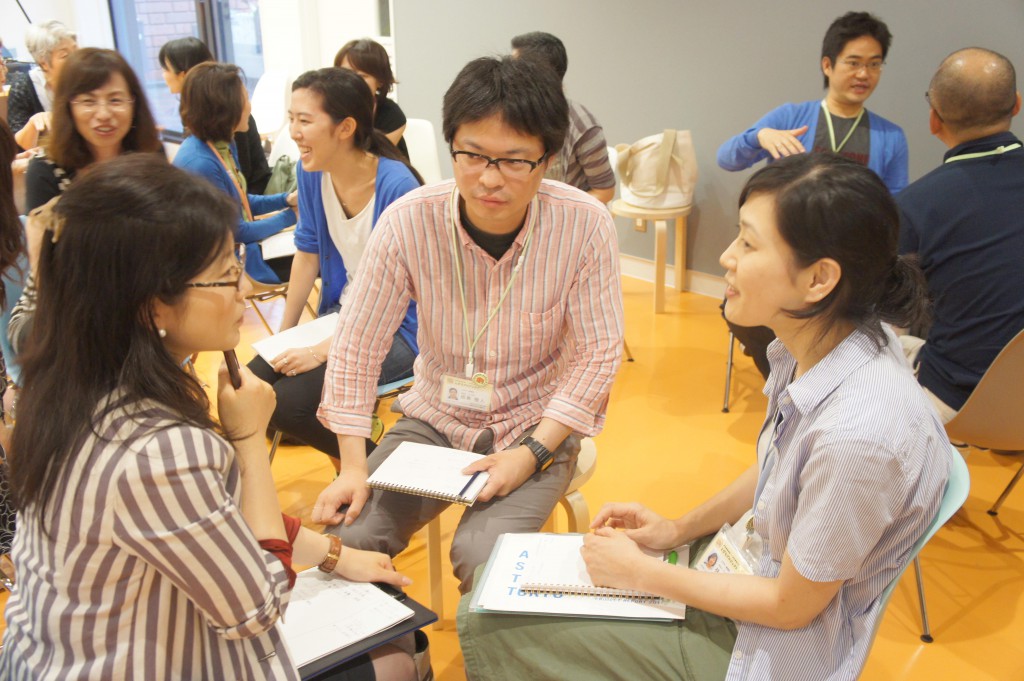
Again, with renewed feeling, we rearranged the groups of three and began talking about “What do you do next?” When thinking about the ideas of “the style of not prioritizing the mission, but whoever happens to be there is everything” and “new public commons” each being the working methods of TOBIRAs, this becomes a very important theme. There was something much deeper than originally expected in the message in the issue of “What do you do next?”
There was a submission regarding this issue not during the Foundation Course, but written on the “Message Board for TOBIRAs.” (I apologize that I cannot give those other than TOBIKOs reading this blog access to this board.…). From here, I plan to progress toward realizing that which seems capable of realization.
—I think there may be a steep road ahead toward the high ideals of the TOBI Gateway Project. With these TOBIKOs, I believe these ideals certainly can be realized. Also, aside from the staff who frequently appears in this blog, there are also staff who work hard supporting the TOBI Gateway Project. From the left, there is Ms. Manabe, our intern, Mrs. Kondo, our coordinator, Ms. Kumagaya, our part time worker, and the curator, Ms. Ohashi (in charge of the The Royal Picture Gallery Mauritshuis (Maurice House) exhibition!). (Sorry if the photo is a bit blurry.) Unfortunately, Mr. Otani, our assistant, isn’t in the picture. He’ll be there next time. Even for “the style of not prioritizing the mission, but whoever happens to be there is everything,” I think we have a great group. (Ito)
“New Public Commons” (「新しい公共」)is an idea, under which not only the government but also citizens, NPOs, private businesses, and other parties, with the spirit of mutual assistance, play an active role in providing services for our everyday life such as education, childcare, community development, nursing care and welfare services. Available at http://www5.cao.go.jp/npc/index-e/index-e.html.
2012.06.09